Compagnie Générale Transatlantique
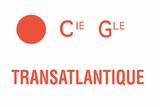 The Transat flag | |
| Industry | Shipping |
|---|---|
| Fate | Merged with Compagnie des Messageries Maritimes to form the Compagnie Générale Maritime |
| Founded | 1861 |
| Founder | Péreire brothers |
| Defunct | 1975 |
| Headquarters | Paris, France |
Key people |
Péreire brothers Jules Charles-Roux John Dal Piaz Henri Cangardel Jean Marie Edmond Lanier |
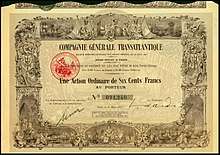
The Compagnie Générale Transatlantique (shortened to "CIE. GLE. TRANSATLANTIQUE", or CGT, and commonly named "Transat"), typically known overseas as the French Line, was a French shipping company. Established in 1855 by the brothers Émile and Issac Péreire under the name Compagnie Générale Maritime, the company was entrusted by the French government to transport mails to North America. In 1861, the name of the company was changed to Compagnie Générale Transatlantique. The company's first vessel, the SS Washington, had its maiden voyage on 15 June 1864. After a period of trials and errors in the late 19th century, the company, under the direction of its presidents Jules Charles-Roux and John Dal Piaz, gained fame in the 1910s and 1930s with its prestigious ocean liners such as SS Paris, SS Île de France, and especially SS Normandie. Fragilized by the Second World War, the company regained its fame in 1962 with the famous SS France, which suffered major competition from air transport and was retired from service in 1974. In 1977, the company merged with the Compagnie des Messageries Maritimes to form the Compagnie Générale Maritime. Then, in 1996, the company Compagnie Générale Maritime merged to form the CMA CGM.
Contrary to what its name suggests, Transat was not content with operating just in the North Atlantic route. It also offered service to Central America and even, for a time, the Pacific coast. From the beginning of the 20th century, it offered crossings between Marseille and Algiers, creating a tourist circuit in North Africa in the 1920s. In the 1930s, the company briefly became involved in aviation through Air France Translatlantique. Other than operating ocean liners, the company also had a significant fleet of freighters. The cargo service was started in the 1900s.
The ocean liners of Transat were often symbolic works of art of their time; they were intended to represent an image of France abroad. The quality of services on board, such as that of meals and wines, had attracted wealthy clientele, including Americans at the time of the Prohibition in the United States. Years after the company's demise, its heritage continues to attract collectors and is showcased in exhibitions.
History
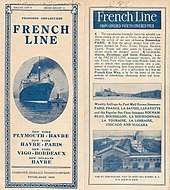
In 1855, the Péreire brothers, Emile and Isaac, created the Compagnie Générale Maritime, which later became the Compagnie Générale Transatlantique. They were already the owners of the Société Générale de Crédit Mobilier, which became the main shareholder. Five years later they signed an agreement with the French government. The company contracted to create a fleet and to provide liner service and carry mail for 20 years on the following routes: Le Havre - New York with calls at Brest, Saint-Nazaire, and the Isthmus of Panama, with 3 additional services for Guadeloupe, Cayenne, and Mexico and. In return, the government would provide the company with an annual subsidy.
In 1861, Compagnie Générale Maritime changed its name to the Compagnie Générale Transatlantique. The Pereire brothers also established a shipyard at Penhoët, near Saint-Nazaire. The next year the first trip to the West Indies and Mexico was made by the ship Louisiane. Two years later the New York - Le Havre line service was begun, with the paddle-steamer Washington providing postal service. In 1867 the company switched from using paddle wheels to using propellers for its vessels, partly because they were more fuel efficient.
An economic and financial crisis in 1868 forced the Pereire brothers to file a petition of bankruptcy and to resign from the company's board. However, the company survived.
Technical progress continued and the company modified its vessels to transport more goods. Still, in 1873 the line suffered its first major accident. The Ville du Havre collided with the sailing ship Loch Earn, with a loss of life of about 226 people.
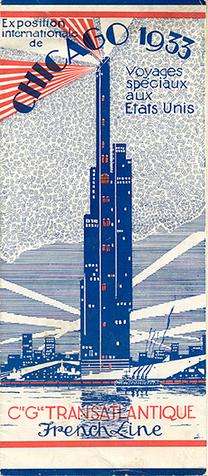
In 1879, the French government awarded the company the concession for postal services for the Mediterranean. That same year the company incorporated. Between 1882 and 1884 the government renewed the earlier fleet and postal agreements.
In 1886, SS La Bourgogne traveled the le Havre - New York transit in a little more than 7 days. This gave the company first place in the New York postal service, and ignited a competition for the record in the trans-Atlantic run. In 1894 the company offered the first cruise for American passengers when La Touraine initiated service from New York to Constantinople.
Between 1897 and 1904, European competition intensified and the company suffered two major maritime disasters. The Ville de Saint-Nazaire had to be abandoned at sea in 1897 and La Bourgogne sank with 568 passengers in 1898. Furthermore, labor strife developed as strikes came to affect all ports and all staff. The strikes continued until 1923.
In 1904, Jules Charles-Roux became president and instituted a reorganization. The company re-oriented its strategy to emphasize the quality of life aboard ship rather than racing against time. The next year it initiated Le Havre - New York cargo service.
The company did not become a major participant of the trans-Atlantic ocean liner trade until after World War I. During 1907 and 1908, when immigration to the United States was greatest, the company's share of the market was a mere 10%. In line with its strategy, the company did not have ships of either great speed or size, but instead became renowned during the early 20th century for its luxuriously appointed liners. The most notable of these early ships was the SS France, which began service in 1912.
During World War I, the company transformed its vessels into warships, hospital vessels and troopships. By the end of the war, the company had lost a third of the fleet. Still, the company recovered during the post-war period, with several famous ships beginning service. In 1927, the SS Ile de France, the first ship to be styled in Art Deco, had its maiden voyage.
The company also diversified. In 1919, it introduced the first tourist motor car circuit in North Africa and in 1925 it created the Société des Voyages et Hôtels Nord-Africains (S.V.H.N.A.).
One of the minor vessels of the CGT - the s/s "Kentucky" - made history of the Polish newly built deep-sea harbour of Gdynia, entering it on Aug. 13, 1923 as the first foreign ship ever to call at Gdynia, still before raising the status of the locality to a town (which occurred on the 10th of Feb. 1926).
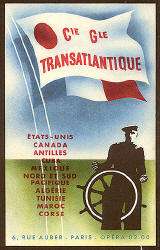
The Great Depression caused the company to suffer a significant decrease of profits as costs increased and passenger numbers plummeted The company responded by decommissioning vessels and discontinuing unprofitable routes. A generous government subsidy enabled the company, in 1935, to finance the construction its most famous vessel, the SS Normandie. At the time of completion, the ship was the largest in the world and also the fastest, winning the Blue Riband from the Italian liner, the SS Rex. Its Art Deco interior and streamlined hull design were famous. It won the Blue Ribbon trophy for its first voyage with a speed of 30 knots. However, it was never a commercial success and a fire in 1942 ended its career.
In 1939-1940, at the beginning of World War II, the company was subject to mobilization of more than a third of the staff. The Department of Shipping & Maritime Transport chartered or requisitioned the company's ships. The company also received 95 vessels to manage for the war effort. By 1946, the loss of several vessels due to the war had diminished the company's fleet, though the company was able to acquire several Liberty ships. The company also acquired Liberté, the former German liner SS Europa (1928), which France had claimed as reparations.
In 1950, the company acquired the Compagnie générale transsaharienne, which operated land and air transport across the Sahara.[1] Passenger traffic grew post-war, but the advent of commercial jet air travel in 1958 was the beginning of the end for the French Line's passenger ships. Despite the launch of a new flagship, the 66,000 ton SS France in 1961, passenger demand decreased as no ship could match the convenience of airplane flights that could transport passengers in a matter of hours over a distance that by ship would take several days. The ocean liner fleet became dependent on government subsidies, which were finally ended in 1974. The fleet was subsequently hulked.
In 1976, the company merged with the Compagnie des Messageries Maritimes de Marseille to form the Compagnie Générale Maritime.[2]
France was laid up until 1979 when the Norwegian Cruise Line bought it and renamed it Norway. In 2008, Norway was beached at Alang, India, and broken up for scrap.
Vessels
CGT Ships included:
- SS Mont-Blanc (1899), munitions ship that exploded in the December 1917 Halifax Explosion
- SS France (1910), one of the least famous "Four stackers"
- SS Illinois (1917), formerly the SS Farnworth, bought and renamed in 1926, sold in 1934 and torpedoed in 1940 as the SS Empire Conveyor
- SS Pensylvanie (1917), sold to Counties Ship Management in 1934 and renamed SS Bury Hill, wrecked off the Senegalese coast in 1936
- SS De Grasse (1924–1953), renamed the RMS Empress of Australia by Canadian Pacific Steamships
- SS Normandie (1932–1942), renamed USS Lafayette by the US Navy; damaged beyond repair by fire in New York
- SS Ingénieur Général Haarbleicher (1945), ran aground 1945, scrapped 1947
- SS Liberté, acquired 1946, formerly the SS Europa of North German Lloyd
- SS Antilles (1953), hit a reef near Mustique in January 1971, caught fire and sank
- SS France (1961), later sold to Norwegian Cruise Line and renamed the SS Norway
References
- ↑ Ferry, Vital (2006). Du trimoteur au quadrijet: le transport aérien en Afrique noire francophone, 1940-1961. Le gerfaut. p. 155. ISBN 978-2-35191-007-8. Retrieved 2014-12-08.
- ↑ "L'Etat vend sa compagnie maritime en pure perteRenflouée de 3 milliards avant la privatisation, la CGM est cédée pour 20 millions à Jacques Saadé". Libération.fr (in French). Retrieved 2017-08-14.
Bibliography
- Rémy, Max; Le Boutilly, Laurent (2016). Les "Provinces" Transatlantiques 1882-1927 (in French). Éditions Minimonde76. ISBN 9782954181820.
- Barbance, Marthe (1955). Histoire de la Compagnie Générale Transatlantique : un siècle d'exploitation maritime (in French). Arts et métiers graphiques.
- Brouard, Jean-Yves (1998). Paquebots de chez nous (in French). MDM. ISBN 2-909313-53-0.
- Le Goff, Olivier (1998). Les Plus Beaux Paquebots du Monde (in French). Solar. ISBN 9782263027994.
- Offrey, Charles (1994). Cette grande dame que fut la Transat (in French). MDV. ISBN 9782910821005.
- Ollivier, Frédéric (2005). "Normandie": un chef-d'œuvre français (1935-1942) (in French). Chasse-marée. ISBN 2914208804.
- Trihan, Ludovic (1991). La Compagnie Générale Transatlantique, histoire de la flotte (in French). Glénat. ISBN 9782723413916.
- Banet-Rivet, Raoul (2012). Souvenirs 1893-1958 (in French). BoD. ISBN 9782810624751.
Further reading
- Miller, William H. Jr., The First Great Ocean Liners in Photographs, 1984, Dover
- Fox, Robert, Liners, the Golden Age, 1999, Könemann
- McAuley, Robert, The Liners, 1997, Boxtree
- Maddocks, Melvin, The Great Liners, 1978, Time-Life
External links
- Passenger Lists of the CGT French Line
- Official website
- French Lines
- The Last Ocean Liners - French Line - trade routes and ships of the French Line during the 1960s and 1970s
- Documents and clippings about Compagnie Générale Transatlantique in the 20th Century Press Archives of the German National Library of Economics (ZBW)
| Wikimedia Commons has media related to Compagnie Générale Transatlantique. |